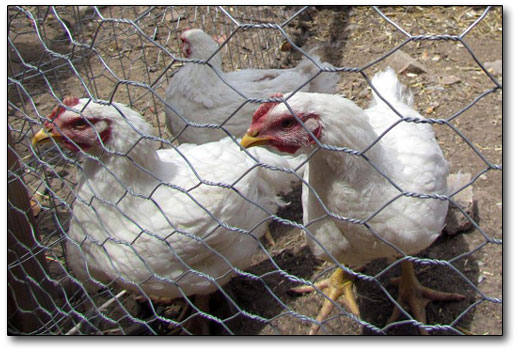|
|
||
Corruption of a chicken farmer
by Ari LeVaux
I prefer my roosters foolish and aggressive enough to run at intruders like succulent kamikazes, because it’s easier to replace a rooster than a hen. But Rusty had a survival instinct, and failed to intervene as various predators pared the flock down to just himself, an old hen named Annabelle 2.0, and another rooster named Marco Pollo. Two roosters and a post-menopausal hen is not a flock with growth potential, though you have to give Rusty credit for trying. His days revolved around humping Annabelle 2.0 as often as possible, to the point that she began spending her days hiding in the coop. This compelled Rusty to pursue prison-style intimacy with Marco Pollo, who didn’t seem to mind. Marco Pollo was a total gentleman to Annabelle 2.0, which made me resent Rusty all the more. A new supply of chicks was clearly necessary in order to jumpstart the flock’s population, and I ordered some. And then, unwilling to let Rusty ravish Annabelle 2.0 to death, I broke my promise and chopped off his head. While my dispatching of Rusty was intended to give Annabelle 2.0 a much-deserved reprieve, Marco Pollo had plans of his own. He filled Rusty’s void and proved to the world, and especially to Annabelle 2.0, that he isn’t gay. With Annabelle 2.0 no better off than she was before, the only good that came from killing Rusty was the spectacular coq au vin I made. Annabelle 2.0 finally died, in her sleep, just hours before the new shipment of baby chicks arrived. She was my first chicken to die of old age, marking the moment with both triumph and sadness. As I watched Marco Pollo raise the new brood alone, the memory of that coq au vin, and the lusty red wine sauce that tamed Rusty’s sinewy flesh, kept me up at night. Breaking my no-kill promise had opened a door in me. A few weeks later I purchased 12 baby Cornish Cross meat-bird chicks. Not only did the meat-birds grow fast physically, but other aspects of their development were expedited as well. At two weeks, they were sheltering the older but smaller layer chicks under their wings like mama hens. At three weeks old, Marco Pollo was already giving them his chicken love, and they would shake exuberantly when he finished. It’s good that there were 12 of them among which to spread his passion. Despite their gluttonous habits, the meat birds were sweethearts, and killing them was going to be a lot harder than killing Rusty was. But there wasn’t any choice. Cornish Cross birds aren’t genetically programmed to handle old age. Their fragile bones break, their joints dislocate, and their hearts stop as they get bigger. At least their lack of fear makes it easier, when the time comes, to catch them. And at least they all look alike – bright white with big feet. Needless to say, they were not given names. Since my farm days, I’ve referred to Gary Snyder’s poem “The Hudsonian Curlew” (from his collection Turtle Island) for butchering guidance: If you already know a little about what you’re doing, these stanzas could be helpful. But despite my affection for the poem, there are irreconcilable differences between wild Hudsonian Curlews and Cornish Cross chickens. These days I use Herrick Kimball’s less elegant but more detailed advice at www.butcherachicken.blogspot.com. The site contains 10 illustrated chapters on slaughtering and cleaning chickens, including one on removing the uropygial oil gland at the base of the tail. The image Kimball provides of his young son singing Bible camp songs while slitting chicken throats is a bit creepy. But in fairness, it’s rare to get through the process of “dressing out” a chicken without getting creeped out one way or another. And I think that’s OK. This business of eating dead animals is a messy affair. It should make you uncomfortable, because it’s a big deal. Which is why I believe all meat eaters should participate, at least once, in the real work of bringing it to the table. |
In this week's issue...
- January 25, 2024
- Bagging it
State plastic bag ban is in full effect, but enforcement varies
- January 26, 2024
- Paper chase
The Sneer is back – and no we’re not talking about Billy Idol’s comeback tour.
- January 11, 2024
- High and dry
New state climate report projects continued warming, declining streamflows


